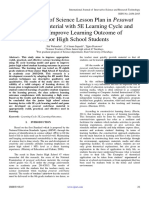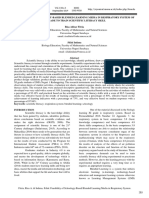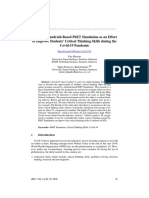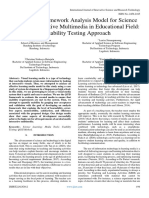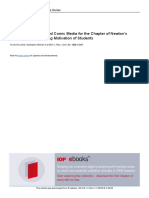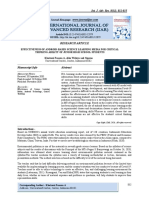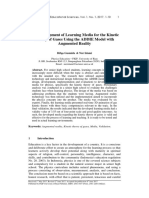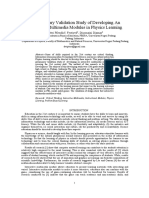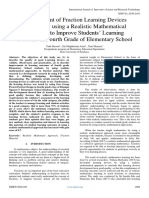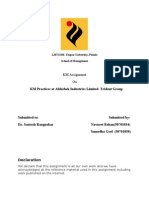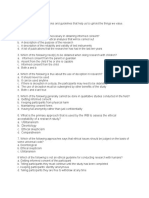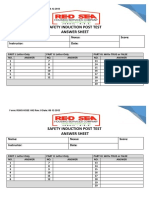Professional Documents
Culture Documents
Development Science Learning Media Based On Ispring Suite 8 To Increase Scientific Literacy at Primary School
Uploaded by
Anonymous izrFWiQOriginal Title
Copyright
Available Formats
Share this document
Did you find this document useful?
Is this content inappropriate?
Report this DocumentCopyright:
Available Formats
Development Science Learning Media Based On Ispring Suite 8 To Increase Scientific Literacy at Primary School
Uploaded by
Anonymous izrFWiQCopyright:
Available Formats
Volume 4, Issue 7, July – 2019 International Journal of Innovative Science and Research Technology
ISSN No:-2456-2165
Development Science Learning Media Based on
Ispring Suite 8 to Increase Scientific Literacy at
Primary School
Marina Putriyani1, Tjandrakirana2, Eko Haryono3
Postgraduate Program of Elementary Education Department,State University of Surabaya
Abstract:- The research that has been done in society, and the universe, as well as problems in modern
developing science learning media based on Ispring society (Kemendikbud, 2017).
Suite 8 with four D model development model to
improve students' scientific literacy in the subject of The computer-based learning media can contain
Sound to producing science learning media. The target difficult simulations through direct experiences so students
of this study is science learning media that tested on 30 can have concrete experiences (santyasa, 2007). In line
grade 4 students at SDN Kandangan I / 121 Surabaya with research carried out by Rosandi (2016) on flash
with One Group Pretest-Postest Design. The analysis of multimedia development of multimedia science that is
the results of the perceives feasible which includes worthy of improving middle school students' science
categories: (1) valid, in accordance with the assessment centers. The above statement can be explained that with the
of the validator to the learning media developed; (2) application of the learning media with computer help will
practical, appropriate for the reliability of students ' motivate and make the lesson more interesting and
learning and activities that are relevant to the lesson; concrete. One of the applications that can be used in media
(3) effective, in according to the results of students' production is ispring suite 8. The ispring suite 8 application
scientific literacy tests that perceive all students can incorporate written, visual, video, and sound materials
complete with N-gain mode and good responses given to make learning more meaningful, appealing, and
by students. This research conclusion, which is a enjoyable. The computer-based learning media can contain
science learning media based on Ispring Suite 8 difficult simulations through firsthand experiences so
deserves to improve the science literacy of primary students can gain experiences.
school students.
The ispring suite 8 learning media can be an
I. INTRODUCTION alternative to concrete delivery of sound material. The
research performed by Himmah (2017) has developed an
Efforts to develop skills in the 21st century that can interactive multimedia-based ispring Suite 8 on sub
be done by teachers, one was science literacy through material additives in class VIII SMP and obtained the
science learning. Science literacy is a scientific skill so results that the multimedia is valid, practical, and effective
that, it can identify questions, acquire new knowledge, to improve student learning outcomes. Ispring Suite 8 is an
explain scientific phenomena, draw conclusions according application that is used to convert presentation files into
to facts, understand the characteristics of science, be aware Flash form and form SCORM/AICC, which is the usual
of science and technology that affect the environment, form of e-learning (Alfiandra, 2016). The features in
intellectually and culturally, and care about related issues Ispring Suite 8 are used to develop learning products in the
science (OECD, 2016). Through science learning, students form of PPT teaching materials, animated videos, and
can get direct experience, so they can receive, store, and quizzes. Learning Media based ispring Suite 8, sound
process information, and develop and apply the concepts material presented in the form of flash, so that students can
they have learned ( Kemendikbud, 2017). gain a concrete experience such as listening to the ears and
are expected to master the concept and able to apply in
The cognitive development of elementary school Daily life. Learning Media such as animation and
students according to Piaget belongs to the category of simulation can provide insight into science learning in
concrete operation is at the age of 7 years to 11 years, at improving student science literacy (Fan and Geelan, 2012).
this stage students can understand logically with the help Similar research has done Azimi (2017) has developed
of concrete objects. In the 2013 curriculum, the elementary science learning based literacy material and nature in class
school level has emphasized the implementation of literacy IV elementary school and obtained the results of learning
strategies for high-thinking skills of elementary school material and nature using Learning Media Based Science
students (Kemendikbud, 2018). The application of Literacy in elementary school is effective and practical.
scientific literacy to elementary school students is needed Previous research on media development aimed to improve
to shape the mindset, behavior and character building so the learning outcomes that can be used as a reference for
that they are caring and responsible for themselves, research to be done.
IJISRT19JUL103 www.ijisrt.com 511
Volume 4, Issue 7, July – 2019 International Journal of Innovative Science and Research Technology
ISSN No:-2456-2165
II. METHOD
The type of this research is development research use
four D model (Thiagarajan dkk ,1974). The objective in
this study is ispring suite 8 based science learning media in The purpose of data analysis in this study was to
improving scientific literacy which will be tested on 30 answer the next research question to formulate
fourth grade students at Kandangan I / 121 Surabaya conclusions. The data analysis used is quantitative
Elementary School. descriptive analysis, which includes:
The tecnique used in this development research is A. Analysis of the validity of learning media
validation, observation, giving tests and question naires. The results of the learning Media validation are
The design of the research used for learning media trials is further analyzed in a quantitative descriptive, by
to use the One Group pretests-posttest. The trial design will calculating the average rating score of the indicator. The
be given pretests and given posttest after treatment. average accrual of the score is converted using the
Research plans by Fraenkel, Wallen, and Hyun (2012) are conditions:
described as follows:
Interval Score Rating category Information
3,6 ≤ P ≤ 4,0 Very valid Can be used without revision
2,6 ≤ P ≤ 3,5 Valid Can be used with the slight revision
1,6 ≤ P ≤ 2,5 Less valid Can be used with many revisoins
1,0 ≤ P ≤ 1,5 Invalid Unable to use still requires consultation
Table 1:- (Ratumanan dan Laurens, 2011)
Testing of the reliability of the instrument using the
following formula : B. Analysis of the Implementation of the Lesson Plan with
the Media
𝐴−𝐵 The analysis of the implementation of the Learning
R = [1 − 𝐴+𝐵 ]x 100% (Borich, 1994)
Plan was analyzed in a quantitative descriptive, by
calculating the results of the packaging by two observers,
Information:
then in the search for a percentage of the implementation
of RPP in the learning process. The percentage of
R = instument of reliability implementation of RPP (P) is as follows:
A = frequency aspect of high values from validator
B = frequency aspect of low values from validator
𝑡ℎ𝑒 𝑛𝑢𝑚𝑏𝑒𝑟 𝑜𝑓 𝑠𝑡𝑎𝑔𝑒 𝑜𝑓 𝑡ℎ𝑒 𝑙𝑒𝑠𝑠𝑜𝑛 𝑝𝑙𝑎𝑛 𝑡ℎ𝑎𝑡 𝑤𝑎𝑟𝑒 𝑠𝑢𝑐𝑐𝑒𝑠𝑠𝑓𝑢𝑙𝑙𝑦 𝑖𝑚𝑝𝑙𝑒𝑚𝑒𝑛𝑡𝑒𝑑
P= x 100%
𝑡𝑜𝑡𝑎𝑙 𝑠𝑡𝑎𝑔𝑒 𝑜𝑓 𝑡ℎ𝑒 𝑙𝑒𝑠𝑠𝑜𝑛 𝑝𝑙𝑎𝑛
Interval Kategori
0% ≤ P < 25% Not done
25%≤ P < 50% Poorly done
50% ≤ P < 75% Well done
75%≤ P < 100% Very well done
Table 2:- Percentage of Criteria Implementation of The Lesson Plan (Riduwan, 2012)
C. Analysisi of Student Activities D. Analysis of Student Activities
Observation data of student activity sheets were The determinant analysis of student's scientific
analyzed using the average percentage formula. The literacy by calculating Normalized Gain by using the gain
average percentage formula is as follows; (Rosidi, 2013) score (score increase) which is done on the overall results
of student's scientific literacy skills.
The amount of increase or N-gain is analyzed using
the following formula:
(𝑆𝑝𝑜𝑠𝑡) − (𝑆𝑝𝑟𝑒)
𝑔=
Students are said to be active if the percentage is (𝑆𝑚𝑎𝑘𝑠) − (𝑆𝑝𝑟𝑒)
more than 50 %, if not then students are said to be not
active in participating in learning.
IJISRT19JUL103 www.ijisrt.com 512
Volume 4, Issue 7, July – 2019 International Journal of Innovative Science and Research Technology
ISSN No:-2456-2165
While the gain classification is as follows: developed by researchers. The student responses are
quantitative descriptively responses are formulated as
g- heigh : (g) > 0,7 follows:
g- medium : 0,7 ≥ (g) ≤ 0,3
g-low : (g) < 0,3 ∑𝑅
P = ∑ x 100 %
𝑁
E. Analysis of Student Response
Riduwan (2012) suggests that studen’t response The percentage of student responses can be converted
questionnaires are used to determine student’s opinions with the following criteria:
about the application of learning tools that have been
Persentase Kriteria
0% - 20% Very less
21% - 40% Less
41% - 60% Enough
61% - 80% Good
81% - 100% Excellent
Table 3:- Percentage of Student Response Criteria (Riduwan,2012)
III. RESULTS AND DISCUSSION
A. The Validity of Learning Media
The results of research a learning media development Validation is measured using instructional media
based on Ispring Suite 8 on the sound that changed validation instrument that researchers create are provided
performed by adapting the 4D model . The following to the expert validators to validate the ispring suite based
results in data analysis of the validity, practicability, and learning media.
effectiveness of iSpring suite based Learning Media:
Fig 1:- Results of the Validity Analysis of Learning Media
Based on the result of the analysis perceive in Figure B. Practicality of Learning Media
1, the average value of the total validity of the ispring suite Practical test of learning media based on the
8 based learning media in the sound material used obtained implementation of learning and student activities.
is 3,55. It can be concluded that the category is “ valid”.
Implementation of Learning
The impleentation of learning in accordance with .
Table 4 Results of Learning Implementation
Implementation.
IJISRT19JUL103 www.ijisrt.com 513
Volume 4, Issue 7, July – 2019 International Journal of Innovative Science and Research Technology
ISSN No:-2456-2165
RPP1 RPP2 RPP3 Implementation
No Assessment Aspect Average
V1 V2 V1 V2 V1 V2 (%)
I. KBM OBSERVATION
A. Opening
1. Saying greetings 4 4 4 4 4 4 4,0 100
2. Giving time for children to pray 4 3 4 4 4 4 3,8 96
3. Checking student attendance 4 3 4 4 4 4 3,8 96
4. Apperception 4 4 4 3 4 4 3,8 96
5. Delivering learning objectives 3 4 4 4 4 4 3,8 96
B Core activities
Creating a learning environment that is ready to be
1 4 3 4 3 4 4 3,7 92
oriented to learning material
Conducting activities that encourage students to
2 4 3 4 3 4 4 3,7 92
formulate problems
Conducting activities that encourage students to
3 4 3 3 3 4 4 3,5 88
form hypotheses
Conducting activities that encourage students to
4 3 3 4 3 3 3 3,2 79
collect data
Conducting activities that encourage students to
5 test hypotheses (conducting experiments / group 4 3 4 3 4 4 3,7 92
discussions)
Conducting activities that encourage students to
6 4 3 4 3 3 4 3,5 88
form conclusions
Guiding students to present the results of group
7 4 3 4 3 4 4 3,7 92
work
8 Guiding students to evaluate 4 3 3 3 4 4 3,5 88
C Closing Activity
1 Guiding students to conclude the material 4 3 4 4 4 4 3,8 96
2 Giving reflection 3 3 4 4 4 4 3,7 92
3 Closing the lesson and give further assignments 3 4 4 4 4 4 3,8 96
II CLASS SITUATION
1 KBM is in accordance with the learning objectives 4 3 4 3 4 4 3,7 92
2 Time allocation as planned 3 3 4 3 4 4 3,5 88
3 Mastery of concepts 4 4 4 3 4 4 3,8 96
4 Class management 3 3 4 3 4 4 3,5 88
Table 4
Based on the results of observations of the implementation of learning with ispring suite-based learning media on sound
material obtained scores from observers of 3.5 to 3.8 with the percentage of 82% to 96% the categories implemented very well.
Student Activities
Table 5 Observation Results of Student Activities
IJISRT19JUL103 www.ijisrt.com 514
Volume 4, Issue 7, July – 2019 International Journal of Innovative Science and Research Technology
ISSN No:-2456-2165
Percentage of each meeting
No Observed Aspects Average (%)
P1 P2 P1 P2 P1 P2
1 Making questions / formulation of the problem 60 67 53 53 80 67 63,3
2 Practicing the use of learning media 87 73 80 87 93 100 86,7
3 Reading teaching materials to find important information 100 80 93 87 93 93 91,1
4 Discussing student work sheet with groups 100 87 80 93 100 100 93,3
Conducting experiments / observations in accordance with the
5 80 80 67 80 100 100 84,4
student work sheet instructions
6 Presenting the results of group discussions 87 60 87 80 87 87 81,1
7 Listening to the presentation 80 80 93 87 87 100 87,8
8 Asking questions / ideas / ideas 53 53 67 67 80 80 66,7
9 Evaluating learning outcomes 80 80 87 87 100 100 88,9
Table 5
Student activity Data During KBM can be categorized actively due to students ' requirements that correspond to the activity
criteria as long as the learning reaches 66.7% to 93.3% (> 50%)
C. Effectiveness of Learning Media
Test the effectiveness of ispring-based learning media based on learning outcomes in determining the skills of Science
literacy and student response.
Science Literacy Skills
Table 6 Results of Science Literacy Tests
No Student Pretest Posttest N-gain Category
Names Score Completeness Score Completeness
1 A1 50 Not Complete 80 Complete 0,6 Sedang
2 B1 30 Not Complete 80 Complete 0,7 Tinggi
3 C1 50 Not Complete 80 Complete 0,6 Sedang
4 A2 20 Not Complete 80 Complete 0,8 Tinggi
5 B2 50 Not Complete 90 Complete 0,8 Tinggi
6 C2 40 Not Complete 90 Complete 0,8 Tinggi
7 A3 60 Not Complete 80 Complete 0,5 Sedang
8 B3 60 Not Complete 90 Complete 0,8 Tinggi
9 C3 60 Not Complete 90 Complete 0,8 Tinggi
10 A4 50 Not Complete 80 Complete 0,6 Sedang
11 B4 80 Complete 90 Complete 0,5 Sedang
12 C4 80 Complete 90 Complete 0,5 Sedang
13 A5 80 Complete 90 Complete 0,5 Sedang
14 B5 50 Not Complete 80 Complete 0,6 Sedang
15 C5 50 Not Complete 80 Complete 0,6 Sedang
16 A6 30 Not Complete 80 Complete 0,7 Tinggi
17 B6 40 Not Complete 80 Complete 0,7 Tinggi
18 C6 30 Not Complete 80 Complete 0,7 Tinggi
19 A7 50 Not Complete 80 Complete 0,6 Sedang
20 B7 40 Not Complete 90 Complete 0,8 Tinggi
21 C7 40 Not Complete 90 Complete 0,8 Tinggi
22 A8 40 Not Complete 80 Complete 0,7 Tinggi
23 B8 40 Not Complete 80 Complete 0,7 Tinggi
24 C8 50 Not Complete 90 Complete 0,8 Tinggi
25 A9 60 Not Complete 80 Complete 0,5 Sedang
26 B9 50 Not Complete 80 Complete 0,6 Sedang
27 C9 40 Not Complete 80 Complete 0,7 Tinggi
28 A10 50 Not Complete 90 Complete 0,8 Tinggi
29 B10 40 Not Complete 90 Complete 0,8 Tinggi
30 C10 30 Not Complete 80 Complete 0,7 Tinggi
Table 6
IJISRT19JUL103 www.ijisrt.com 515
Volume 4, Issue 7, July – 2019 International Journal of Innovative Science and Research Technology
ISSN No:-2456-2165
Information : U1 = Pretest
U2 = Posttest
Table 6 perceives that learning media based on Ipsring's suite of sound materials can improve student science literacy
characterized by increased score between before and after learning.
Student Response
No Questions Student Response (%)
Yes No
1 The topic of learning media is in accordance with sound material 100 0
2 Allocation of time given is enough to complete all sound material 86,7 13,3
3 Display of ispring suite 8 based learning media is interesting 100 0
4 The concept of material is presented in sequence 86,7 13,3
5 Learning media can help students find concepts 100 0
6 The language used in learning media is according to EYD 80 20
7 Learning media can motivate students to be actively involved in learning 90 10
8 Learning media explain material that is not observed by the eye 100 0
9 Learning media can help students analyze problems in everyday life 100 0
10 Learning media can make it easier to learn sound material 100 0
11 Learning media can help students have scientific literacy in sound material. 90 10
12 Do you find it easy to answer the items in scientific literacy tests 90 10
93,6 6,4
Table 7:- Results of Student Response
Based on table 7 perceives that the learning has been [6]. Ratumanan, G.T. & Laurens, T. 2011. Evaluasi Hasil
done with a very strong response from the students. Most Belajar pada Tingkat Satuan Pendidikan. Surabaya:
students respond positively to the learning that has been UNESA University Press.
done. It can be seen from the average repos provided by [7]. Riduwan. 2012. Metode & Teknik Menyusun
students, which is 93.6% of students give a positive Proposal Penelitian. Bandung: Alfabeta
response and 6.4% give a negative response. [8]. Sahlan, Asmaun & Angga Teguh Prastyo. 2012.
Desain Pembelajaran Berbasis Pendidikan Karakter.
IV. CONCLUSION Jogjakarta : Ar-Ruzz Media
The results of the research and the conclusion
discussion on science learning media based on Ispring
Suite 8 which has been developed in terms of validity and
that includes the validation of learning media and learning
devices, practicality includes implementation Students '
learning and activities, while the effectiveness of the
students ' science literacy test results and student responses
in improving the science literacy of elementary school
students.
REFERENCES
[1]. Alfiandra & Mulkan, Mulyadi. 2016. Pengembangan
Produk Pembelajaran Melalui Media Ipring pada
Mata PPKn di SMK Palembang. Jurnal Bhinneka
Tunggal Ika, vol 3, no 1, Mei 2016.
[2]. Borich, Gary D. 1994. Observation Skills for
Effective Teaching. The University of Texas: USA
[3]. Clark, R. C., & Mayer, R. E. 2011. E-Learning and
the Science of Instruction. Amerika: Pfeiffer.
[4]. Kemendikbud. 2017. Kompetensi Inti dan
Kompetensi Dasar Sekolah Menengah
Pertama/Madrasah Tsanawiyah. Jakarta.
[5]. Permendikbud No. 67 Tahun 2013 Tentang Kerangka
Dasar dan Struktur Kurikulum Sekolah
Dasar/Madrasah Ibtidaiyah. Jakarta
IJISRT19JUL103 www.ijisrt.com 516
You might also like
- Development of Learning Content in Computer Based Media With Articulate Storyline To Improve Civiccs Learning Outcomes in Third Grade Elementary School StudentsDocument8 pagesDevelopment of Learning Content in Computer Based Media With Articulate Storyline To Improve Civiccs Learning Outcomes in Third Grade Elementary School StudentsInternational Journal of Innovative Science and Research TechnologyNo ratings yet
- 127-Article Text-529-1-10-20230711Document8 pages127-Article Text-529-1-10-20230711ppg.asr.0226No ratings yet
- Q4 Development of Learning Media Using Android-Based Articulate Storyline Software For Teaching Algebra in Junior High SchoolDocument8 pagesQ4 Development of Learning Media Using Android-Based Articulate Storyline Software For Teaching Algebra in Junior High SchoolLidra Ety Syahfitri HarahapNo ratings yet
- Development of Science Lesson Plan in Pesawat Sederhana Material With 5E Learning Cycle and Game To Improve Learning Outcome of Junior High School StudentsDocument8 pagesDevelopment of Science Lesson Plan in Pesawat Sederhana Material With 5E Learning Cycle and Game To Improve Learning Outcome of Junior High School StudentsAnonymous izrFWiQNo ratings yet
- Bioedu: Berkala Ilmiah Pendidikan BiologiDocument9 pagesBioedu: Berkala Ilmiah Pendidikan Biologihello helloNo ratings yet
- Developing math videos using Powtoon appDocument13 pagesDeveloping math videos using Powtoon appDona Dinda PratiwiNo ratings yet
- Implement Blended Learning Disaster Nursing AppsDocument9 pagesImplement Blended Learning Disaster Nursing AppsZilbran BerontaxNo ratings yet
- 962-Article Text-9740-1-10-20240327Document10 pages962-Article Text-9740-1-10-20240327I Gde MikaNo ratings yet
- I J I E: Ndonesian Ournal of Nformatics DucationDocument12 pagesI J I E: Ndonesian Ournal of Nformatics Ducationakun bersamaNo ratings yet
- Android-based learning media on Plantae materialDocument7 pagesAndroid-based learning media on Plantae materialRusdi BioNo ratings yet
- Project, Technology and Active (PROTECTIVE) Learning Model To Develop Digital Literacy Skills in The 21st CenturyDocument5 pagesProject, Technology and Active (PROTECTIVE) Learning Model To Develop Digital Literacy Skills in The 21st CenturyFatkhurRohmanNo ratings yet
- 125958162 (1)Document3 pages125958162 (1)16KADEK KOVALEVISKA OKANIAWANNo ratings yet
- MI TUGAS 3 - 7A - Ilham Nursya'bani-021Document5 pagesMI TUGAS 3 - 7A - Ilham Nursya'bani-021Ilham Nursya baniNo ratings yet
- The Use of Android-Based Phet Simulation As An Effort To Improve Students' Critical Thinking Skills During The Covid-19 PandemicDocument11 pagesThe Use of Android-Based Phet Simulation As An Effort To Improve Students' Critical Thinking Skills During The Covid-19 PandemicArthaNo ratings yet
- Trigonometry Instructional Video Development in Mathematics InstructionDocument8 pagesTrigonometry Instructional Video Development in Mathematics InstructionPsychology and Education: A Multidisciplinary JournalNo ratings yet
- Developing Framework Analysis Model For Science Learning Interactive Multimedia in Educational Field A Usability Testing ApproachDocument12 pagesDeveloping Framework Analysis Model For Science Learning Interactive Multimedia in Educational Field A Usability Testing ApproachInternational Journal of Innovative Science and Research TechnologyNo ratings yet
- Miaz 2019 J. Phys. Conf. Ser. 1321 032107Document6 pagesMiaz 2019 J. Phys. Conf. Ser. 1321 032107Fia AlifNo ratings yet
- Handout Development Based On Crossword Puzzles in Economic LessonsDocument5 pagesHandout Development Based On Crossword Puzzles in Economic LessonsInternational Journal of Innovative Science and Research TechnologyNo ratings yet
- Sastradika 2021 J. Phys. - Conf. Ser. 1869 012180Document7 pagesSastradika 2021 J. Phys. - Conf. Ser. 1869 012180wisnu faisalNo ratings yet
- Developing of Students Worksheets Through STEM Approach To Train Critical Thinking SkillsDocument7 pagesDeveloping of Students Worksheets Through STEM Approach To Train Critical Thinking SkillsLola JovitaNo ratings yet
- 4993 17115 2 PBDocument10 pages4993 17115 2 PBFertianus WaruwuNo ratings yet
- Development of Android Comic Media For The Chapter of Newton's Gravity To Map Learning Motivation of StudentsDocument11 pagesDevelopment of Android Comic Media For The Chapter of Newton's Gravity To Map Learning Motivation of Studentssyafrida_hadiNo ratings yet
- Improving Civic Education Learning with Pop-up BooksDocument9 pagesImproving Civic Education Learning with Pop-up BooksKreunik ArtNo ratings yet
- Developing Interactive Physics Mobile Learning MediaDocument10 pagesDeveloping Interactive Physics Mobile Learning MediawilathasphieNo ratings yet
- Media Analysis in Development of Physics E-Module Integrated With Tsunami DisasterDocument5 pagesMedia Analysis in Development of Physics E-Module Integrated With Tsunami DisasterJuniza atikaNo ratings yet
- The Development of Physics Learning Instrument Based On Hypermedia and Its Influence On The Student Problem Solving SkillDocument7 pagesThe Development of Physics Learning Instrument Based On Hypermedia and Its Influence On The Student Problem Solving SkillIrvan NRNo ratings yet
- Arifin 2021 J. Phys. Conf. Ser. 1876 012052Document11 pagesArifin 2021 J. Phys. Conf. Ser. 1876 012052Agus PramonoNo ratings yet
- Developing Interactive Science Learning MediaDocument10 pagesDeveloping Interactive Science Learning MediaHardiani AlviaNo ratings yet
- Effectiveness of Android-Based Science Learning Media For Critical Thinking Ability of Junior High School StudentsDocument4 pagesEffectiveness of Android-Based Science Learning Media For Critical Thinking Ability of Junior High School StudentsKhoironi Fanana AkbarNo ratings yet
- 2 - Integrating Technology in Reading - ProposalDocument10 pages2 - Integrating Technology in Reading - ProposalGodofredo EclarinalNo ratings yet
- The Development of Instructional Media On Physics Subject To Increase The Class EffectivenessDocument5 pagesThe Development of Instructional Media On Physics Subject To Increase The Class EffectivenessHapsari PeniNo ratings yet
- Flip Komikesari Nov 2020Document11 pagesFlip Komikesari Nov 2020sofianiddaNo ratings yet
- Binari-Friska IJRR Juni 2019Document11 pagesBinari-Friska IJRR Juni 2019Binari ManurungNo ratings yet
- Development of Android-Based Chemistry Learning Media Oriented Towards Generic Science SkillsDocument9 pagesDevelopment of Android-Based Chemistry Learning Media Oriented Towards Generic Science SkillsmuhammadsaenalNo ratings yet
- ICT learning media comparative studies: simulation, e-modules, videos improve science learning outcomesDocument11 pagesICT learning media comparative studies: simulation, e-modules, videos improve science learning outcomesAhmad Naufal UmamNo ratings yet
- Jurnal Okta Fitriani Autoplay InternasionalDocument13 pagesJurnal Okta Fitriani Autoplay InternasionalyusupNo ratings yet
- Ok Case 16905-45174-4-PBDocument8 pagesOk Case 16905-45174-4-PBRizky MaulidaNo ratings yet
- Technology Based Instructional MaterialsDocument31 pagesTechnology Based Instructional MaterialsRenz RenzNo ratings yet
- Publikasi Ridho Pahlawan JPI Undiksha 2021Document10 pagesPublikasi Ridho Pahlawan JPI Undiksha 2021Putra Dewa R WNo ratings yet
- 599-Article Text-3405-1-10-20210410Document5 pages599-Article Text-3405-1-10-20210410rsjpdowadirperencanaanNo ratings yet
- Android-Assisted Physics Mobile Learning To Improve Senior High School Students' Divergent Thinking Skills and Physics HOTSDocument13 pagesAndroid-Assisted Physics Mobile Learning To Improve Senior High School Students' Divergent Thinking Skills and Physics HOTSbettyNo ratings yet
- The Effect of Multimedia (2016)Document8 pagesThe Effect of Multimedia (2016)Khoiriah ChannelNo ratings yet
- The Effect of Applying Blended Learning Strategies Flipped Classroom Model On Students' Critical Thinking SkillsDocument8 pagesThe Effect of Applying Blended Learning Strategies Flipped Classroom Model On Students' Critical Thinking Skills0071. LussyfebrianiNo ratings yet
- 17254-Article Text-60518-3-10-20220530Document10 pages17254-Article Text-60518-3-10-20220530keirot7No ratings yet
- Artikel-Arini Citra DewiDocument5 pagesArtikel-Arini Citra DewiAriniNo ratings yet
- Artikel Penelitian IndriyanaDocument13 pagesArtikel Penelitian IndriyanaIndri SuyitnoNo ratings yet
- The Development of Learning Media For The Kinetic Theory of Gases Using The ADDIE Model With Augmented RealityDocument10 pagesThe Development of Learning Media For The Kinetic Theory of Gases Using The ADDIE Model With Augmented RealityIrfan FazailNo ratings yet
- Technology-Based Instructional Materials Acceptability Araling PanlipunanDocument25 pagesTechnology-Based Instructional Materials Acceptability Araling PanlipunanAquino Mangilala UdtogNo ratings yet
- A Preliminary Validation Study of Developing An Interactive Multimedia Modules in Physics LearningDocument6 pagesA Preliminary Validation Study of Developing An Interactive Multimedia Modules in Physics Learningrenzon272No ratings yet
- 20219-Article Text-72146-4-10-20230102 PDFDocument8 pages20219-Article Text-72146-4-10-20230102 PDFAbun PemberdayaanNo ratings yet
- 6066 17088 2 PBDocument11 pages6066 17088 2 PBputriNo ratings yet
- 5 - Teaching Science To Grade 4 Pupils Through ICT - ProposalDocument10 pages5 - Teaching Science To Grade 4 Pupils Through ICT - ProposalGodofredo EclarinalNo ratings yet
- Development of Multimedia Physics Learning Integrated With Packing Preparation of Learning Tools in Senior High SchoolDocument9 pagesDevelopment of Multimedia Physics Learning Integrated With Packing Preparation of Learning Tools in Senior High SchoolfapriliaNo ratings yet
- Development of Fraction Learning Devices Material by Using A Realistic Mathematical Approach To Improve Students' Learning Outcome in Fourth Grade of Elementary SchoolDocument5 pagesDevelopment of Fraction Learning Devices Material by Using A Realistic Mathematical Approach To Improve Students' Learning Outcome in Fourth Grade of Elementary SchoolAnonymous izrFWiQNo ratings yet
- Journal of Innovative Science Education: Muh. Komari, Priyantini Widiyaningrum, Partaya PartayaDocument8 pagesJournal of Innovative Science Education: Muh. Komari, Priyantini Widiyaningrum, Partaya Partayariza IbadNo ratings yet
- Interactive Games SingatongDocument12 pagesInteractive Games SingatongNhoj Naxe Yer LlorenteNo ratings yet
- The New Face of Digital Books in Genetic Learning: A Preliminary Development Study For Students' Critical ThinkingDocument16 pagesThe New Face of Digital Books in Genetic Learning: A Preliminary Development Study For Students' Critical ThinkingNur SafirahNo ratings yet
- International Journal of Instruction JanuaryDocument16 pagesInternational Journal of Instruction JanuaryJorge Gamboa VelasquezNo ratings yet
- Evaluation of Assessing The Purity of Sesame Oil Available in Markets of India Using Bellier Turbidity Temperature Test (BTTT)Document4 pagesEvaluation of Assessing The Purity of Sesame Oil Available in Markets of India Using Bellier Turbidity Temperature Test (BTTT)Anonymous izrFWiQNo ratings yet
- IJISRT19AUG928Document6 pagesIJISRT19AUG928Anonymous izrFWiQNo ratings yet
- Analysis of Ancol Beach Object Development Using Business Model Canvas ApproachDocument8 pagesAnalysis of Ancol Beach Object Development Using Business Model Canvas ApproachAnonymous izrFWiQNo ratings yet
- Teacher Leaders' Experience in The Shared Leadership ModelDocument4 pagesTeacher Leaders' Experience in The Shared Leadership ModelAnonymous izrFWiQNo ratings yet
- IJISRT19AUG928Document6 pagesIJISRT19AUG928Anonymous izrFWiQNo ratings yet
- Platelet-Rich Plasma in Orthodontics - A ReviewDocument6 pagesPlatelet-Rich Plasma in Orthodontics - A ReviewAnonymous izrFWiQNo ratings yet
- Incidence of Temporary Threshold Shift After MRI (Head and Neck) in Tertiary Care CentreDocument4 pagesIncidence of Temporary Threshold Shift After MRI (Head and Neck) in Tertiary Care CentreAnonymous izrFWiQNo ratings yet
- Investigations On BTTT As Qualitative Tool For Identification of Different Brands of Groundnut Oils Available in Markets of IndiaDocument5 pagesInvestigations On BTTT As Qualitative Tool For Identification of Different Brands of Groundnut Oils Available in Markets of IndiaAnonymous izrFWiQNo ratings yet
- Bioadhesive Inserts of Prednisolone Acetate For Postoperative Management of Cataract - Development and EvaluationDocument8 pagesBioadhesive Inserts of Prednisolone Acetate For Postoperative Management of Cataract - Development and EvaluationAnonymous izrFWiQNo ratings yet
- Knowledge and Utilisation of Various Schemes of RCH Program Among Antenatal Women and Mothers Having Less Than Five Child in A Semi-Urban Township of ChennaiDocument5 pagesKnowledge and Utilisation of Various Schemes of RCH Program Among Antenatal Women and Mothers Having Less Than Five Child in A Semi-Urban Township of ChennaiAnonymous izrFWiQNo ratings yet
- Design and Analysis of Humanitarian Aid Delivery RC AircraftDocument6 pagesDesign and Analysis of Humanitarian Aid Delivery RC AircraftAnonymous izrFWiQNo ratings yet
- A Wave Energy Generation Device Using Impact Force of A Breaking Wave Based Purely On Gear CompoundingDocument8 pagesA Wave Energy Generation Device Using Impact Force of A Breaking Wave Based Purely On Gear CompoundingAnonymous izrFWiQNo ratings yet
- Securitization of Government School Building by PPP ModelDocument8 pagesSecuritization of Government School Building by PPP ModelAnonymous izrFWiQNo ratings yet
- Closure of Midline Diastema by Multidisciplinary Approach - A Case ReportDocument5 pagesClosure of Midline Diastema by Multidisciplinary Approach - A Case ReportAnonymous izrFWiQNo ratings yet
- Experimental Investigation On Performance of Pre-Mixed Charge Compression Ignition EngineDocument5 pagesExperimental Investigation On Performance of Pre-Mixed Charge Compression Ignition EngineAnonymous izrFWiQNo ratings yet
- Women in The Civil Service: Performance, Leadership and EqualityDocument4 pagesWomen in The Civil Service: Performance, Leadership and EqualityAnonymous izrFWiQNo ratings yet
- Comparison of Continuum Constitutive Hyperelastic Models Based On Exponential FormsDocument8 pagesComparison of Continuum Constitutive Hyperelastic Models Based On Exponential FormsAnonymous izrFWiQNo ratings yet
- Child Rights Violation and Mechanism For Protection of Children Rights in Southern Africa: A Perspective of Central, Eastern and Luapula Provinces of ZambiaDocument13 pagesChild Rights Violation and Mechanism For Protection of Children Rights in Southern Africa: A Perspective of Central, Eastern and Luapula Provinces of ZambiaAnonymous izrFWiQNo ratings yet
- Exam Anxiety in Professional Medical StudentsDocument5 pagesExam Anxiety in Professional Medical StudentsAnonymous izrFWiQ100% (1)
- SWOT Analysis and Development of Culture-Based Accounting Curriculum ModelDocument11 pagesSWOT Analysis and Development of Culture-Based Accounting Curriculum ModelAnonymous izrFWiQNo ratings yet
- Application of Analytical Hierarchy Process Method On The Selection Process of Fresh Fruit Bunch Palm Oil SupplierDocument12 pagesApplication of Analytical Hierarchy Process Method On The Selection Process of Fresh Fruit Bunch Palm Oil SupplierAnonymous izrFWiQNo ratings yet
- Enhanced Opinion Mining Approach For Product ReviewsDocument4 pagesEnhanced Opinion Mining Approach For Product ReviewsAnonymous izrFWiQNo ratings yet
- Risk Assessment: A Mandatory Evaluation and Analysis of Periodontal Tissue in General Population - A SurveyDocument7 pagesRisk Assessment: A Mandatory Evaluation and Analysis of Periodontal Tissue in General Population - A SurveyAnonymous izrFWiQNo ratings yet
- Assessment of Health-Care Expenditure For Health Insurance Among Teaching Faculty of A Private UniversityDocument7 pagesAssessment of Health-Care Expenditure For Health Insurance Among Teaching Faculty of A Private UniversityAnonymous izrFWiQNo ratings yet
- Pharmaceutical Waste Management in Private Pharmacies of Kaski District, NepalDocument23 pagesPharmaceutical Waste Management in Private Pharmacies of Kaski District, NepalAnonymous izrFWiQNo ratings yet
- Trade Liberalization and Total Factor Productivity of Indian Capital Goods IndustriesDocument4 pagesTrade Liberalization and Total Factor Productivity of Indian Capital Goods IndustriesAnonymous izrFWiQNo ratings yet
- Effect Commitment, Motivation, Work Environment On Performance EmployeesDocument8 pagesEffect Commitment, Motivation, Work Environment On Performance EmployeesAnonymous izrFWiQNo ratings yet
- To Estimate The Prevalence of Sleep Deprivation and To Assess The Awareness & Attitude Towards Related Health Problems Among Medical Students in Saveetha Medical CollegeDocument4 pagesTo Estimate The Prevalence of Sleep Deprivation and To Assess The Awareness & Attitude Towards Related Health Problems Among Medical Students in Saveetha Medical CollegeAnonymous izrFWiQNo ratings yet
- The Influence of Benefits of Coastal Tourism Destination On Community Participation With Transformational Leadership ModerationDocument9 pagesThe Influence of Benefits of Coastal Tourism Destination On Community Participation With Transformational Leadership ModerationAnonymous izrFWiQNo ratings yet
- Revived Article On Alternative Therapy For CancerDocument3 pagesRevived Article On Alternative Therapy For CancerAnonymous izrFWiQNo ratings yet
- Revisied Final Ecs 2040 ManualDocument113 pagesRevisied Final Ecs 2040 Manualapi-346209737No ratings yet
- Bar - Bar Waiter-EssDocument3 pagesBar - Bar Waiter-EssSebastia Felipe SolisNo ratings yet
- Creativity PresentationDocument26 pagesCreativity PresentationDivyansh TomarNo ratings yet
- How To Have A Great Marriage - Bo SanchezDocument23 pagesHow To Have A Great Marriage - Bo SanchezLady Marquez100% (12)
- VK Shape Surface KaDocument8 pagesVK Shape Surface KamatthiessamNo ratings yet
- Mathematics Quiz 1 Prelims Kuya MeccsDocument13 pagesMathematics Quiz 1 Prelims Kuya MeccsBeng BebangNo ratings yet
- Sermon Notes: "Restore Us To Yourself, O Lord" (Lamentations 5)Document3 pagesSermon Notes: "Restore Us To Yourself, O Lord" (Lamentations 5)NewCityChurchCalgaryNo ratings yet
- TridentDocument9 pagesTridentShikha GuptaNo ratings yet
- Creating Character: By: Annie Besant and C.W. LeadbeaterDocument25 pagesCreating Character: By: Annie Besant and C.W. Leadbeaterxenocid3rNo ratings yet
- Stockhausen Listening Guide - Gesang Der JunglingeDocument7 pagesStockhausen Listening Guide - Gesang Der JunglingetoddjdNo ratings yet
- Baumgartner Salto PDFDocument8 pagesBaumgartner Salto PDFJaimeNo ratings yet
- To Be Registered From 3 Semester of StudyDocument2 pagesTo Be Registered From 3 Semester of Studyimfarhan 1301No ratings yet
- 5th Sem Strategic Management Notes by Yatharth ChauhanDocument63 pages5th Sem Strategic Management Notes by Yatharth ChauhanVikas Prajapati100% (5)
- Research Ethics GuideDocument4 pagesResearch Ethics GuideJasmy PaulNo ratings yet
- Terminal Performance Objective: A Detailed Lesson Plan in English For Grade 8 I. ObjectivesDocument12 pagesTerminal Performance Objective: A Detailed Lesson Plan in English For Grade 8 I. ObjectivesEdgar Gante Jr.No ratings yet
- BgitaDocument170 pagesBgitasuba100% (1)
- Characteristics of A Good PolicyDocument12 pagesCharacteristics of A Good PolicyvuminyembeNo ratings yet
- Retire Statistical Significance NatureDocument3 pagesRetire Statistical Significance NaturebNo ratings yet
- Reading Comprehension WorksheetsTerms of UseDocument25 pagesReading Comprehension WorksheetsTerms of UseSílvia Maria Vieira60% (5)
- The Gods in Philippine Mythology EpicsDocument16 pagesThe Gods in Philippine Mythology EpicsMAGNUS MAUNo ratings yet
- Legal Ethics Case Digest on Prohibitions for Government LawyersDocument6 pagesLegal Ethics Case Digest on Prohibitions for Government LawyersMel Loise Delmoro100% (1)
- Laila Majnoon and IndiaDocument29 pagesLaila Majnoon and IndiaPunnakayamNo ratings yet
- Safety Induction Post Test Answer Sheet: Name: Nexus: Score: Instructor: DateDocument1 pageSafety Induction Post Test Answer Sheet: Name: Nexus: Score: Instructor: DateJunard Lu HapNo ratings yet
- Dasamsa-Loss and Gain in CareerDocument75 pagesDasamsa-Loss and Gain in Careerarthicse100% (9)
- WESTERMAN, Jonah. Between Action and Image - Performance As Inframedium' (2015)Document4 pagesWESTERMAN, Jonah. Between Action and Image - Performance As Inframedium' (2015)BIAGIOPECORELLINo ratings yet
- Insights Daily Answer Writing Challenge (Public Administration) Day-2 - INSIGHTSDocument9 pagesInsights Daily Answer Writing Challenge (Public Administration) Day-2 - INSIGHTSVinodk2010No ratings yet
- Coleridge Biographia LiterariaDocument4 pagesColeridge Biographia LiterariaLivia BurbuleaNo ratings yet
- Critique a Journal ArticleDocument2 pagesCritique a Journal ArticleRosanyanti Mokhtar100% (1)
- Exploring Filipino TraditionsDocument6 pagesExploring Filipino TraditionsAshley TañamorNo ratings yet
- Pythagorean Theorem Math PDFDocument2 pagesPythagorean Theorem Math PDFapi-201420601No ratings yet



